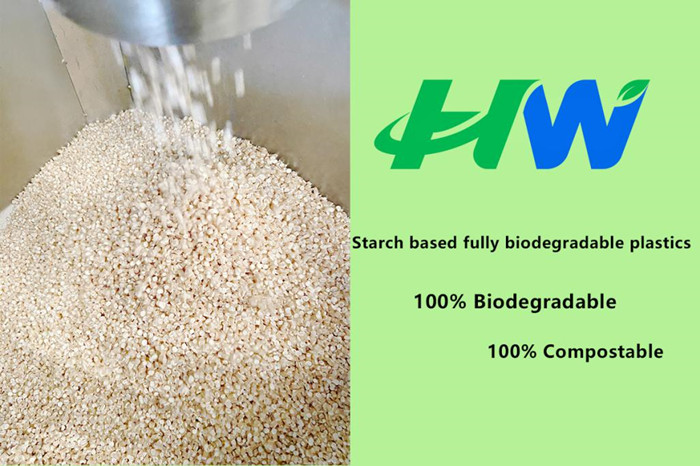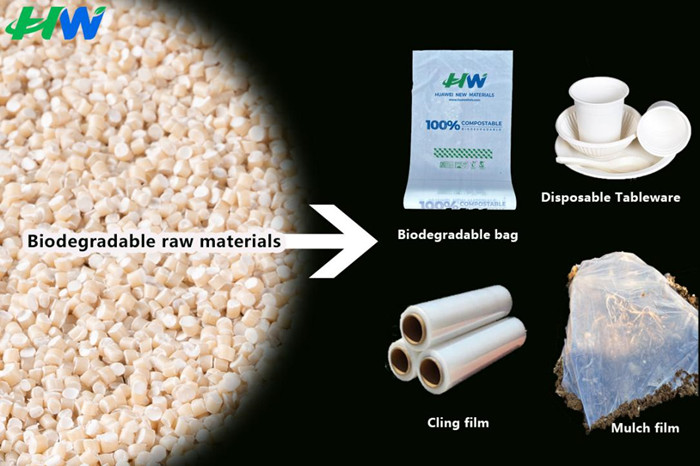Biodegradable plastics refer to a type of plastic that is degraded by natural microorganisms such as bacteria, fungi, and algae. The ideal biodegradable plastic is a polymer material with excellent performance, which can be completely decomposed by environmental microorganisms after disposal, and ultimately become an integral part of the carbon cycle in nature by being inorganic. Biodegradable plastics, also known as biodegradable plastics, refer to plastics that are degraded by naturally occurring microorganisms under natural conditions such as soil and/or sandy soil, and/or specific conditions such as composting, anaerobic digestion, or aqueous culture media, and ultimately completely degraded into carbon dioxide (CO ₂) and/or methane (CH ₄), water (H ₂ O) and their mineralized inorganic salts, as well as new biomass.
According to the source of raw materials, biodegradable plastics can be divided into two categories: bio based biodegradable plastics and petrochemical based biodegradable plastics.
Biobased biodegradable plastics can be mainly divided into four categories: the first category is plastics directly processed from natural materials; The second type is polymers obtained through the joint participation of microbial fermentation and chemical synthesis; The third type is polymers synthesized directly by microorganisms; The fourth category refers to biodegradable plastics obtained by blending or processing these materials with other chemically synthesized biodegradable plastics.
Petrochemical based biodegradable plastics refer to plastics obtained by chemically synthesizing monomers of petrochemical products, such as PBAT, polybutylene succinate (PBS), carbon dioxide copolymers (PPC), etc.

According to the classification of biodegradation processes, biodegradable plastics can be divided into two types: fully biodegradable plastics and destructive biodegradable plastics. Destructive biodegradable plastics currently mainly include starch modified (or filled) polyethylene PE, polypropylene PP, polyvinyl chloride PVC, polystyrene PS, etc.
Fully biodegradable plastics are mainly made from natural polymers (such as starch, cellulose, chitin) or agricultural products through microbial fermentation or synthesis of biodegradable polymers, such as thermoplastic starch plastics, aliphatic polyesters, polylactic acid, starch/polyvinyl alcohol, etc.
Biodegradable plastics based on natural substances such as starch mainly include the following products: polylactic acid (PLA), polyhydroxyalkanoates (PHA), starch plastics, bioengineered plastics, and bio universal plastics (polyolefins and polyvinyl chloride).
Biodegradable plastics, due to their excellent biodegradability, are mainly used as soft and hard packaging materials for food, which is currently their largest application field.

The main target markets for biodegradable plastics are plastic packaging films, agricultural films, disposable plastic bags, and disposable plastic tableware.
Compared to traditional plastic packaging materials, the cost of new biodegradable materials is slightly higher. However, with the increasing awareness of environmental protection, people are willing to use new biodegradable materials with slightly higher prices to protect the environment. The strengthening of environmental awareness has brought huge development opportunities to the biodegradable new materials industry. With the development of the Chinese economy and the successful hosting of large-scale events such as the Olympics and World Expo that have shocked the world, the need to protect various world cultural heritage sites and national scenic spots has led to an increasing emphasis on environmental pollution caused by plastics. Governments at all levels have listed the control of white pollution as one of their key tasks.
Developed countries and regions such as Europe, the United States, and Japan have successively formulated and introduced relevant regulations to restrict the use of non degradable plastics through measures such as partial bans, restrictions, mandatory collection, and pollution taxes. They have vigorously developed biodegradable new materials to protect the environment and soil. Among them, France introduced a policy in 2005 that all disposable plastic bags that can be carried must be biodegradable after 2010.
By 2019, the market value of the biodegradable plastics industry will grow at an average annual growth rate of 13.01% to $3.477 billion. The European biodegradable plastic market is expected to grow at an average annual rate of 12% from 2014 to 2019.
Biodegradable plastics are entering a period of rapid development. Although the concept of biodegradable plastics has been hyped up before, its application has never been fully realized.
Biodegradable plastics are mainly used in packaging, fiber, agriculture, injection molding and other fields, with the most extensive application in the packaging industry, accounting for about 60% of the total market in 2013. Food packaging demand also accounts for more than 70% of the biodegradable plastic packaging market share; The injection molding application market is the main driving force for the growth of demand for biodegradable plastics. As of the end of 2013, Europe and America were the main markets for biodegradable plastics. According to statistics, in 2013, biodegradable plastics accounted for 54% and 28% of the global market in Europe and North America, respectively.
The Environment Committee of the European Parliament has passed a draft on reducing the use of disposable lightweight plastic bags. The draft proposes that the 28 member states of the European Union adopt a two-step approach to effectively reduce the use of plastic bags, in order to achieve the goal of reducing the use of ultra-thin plastic bags by 80% in 2019 compared to 2010. This resolution is expected to greatly stimulate the market demand for biodegradable plastics and create huge growth opportunities for related manufacturers in the next five years.
